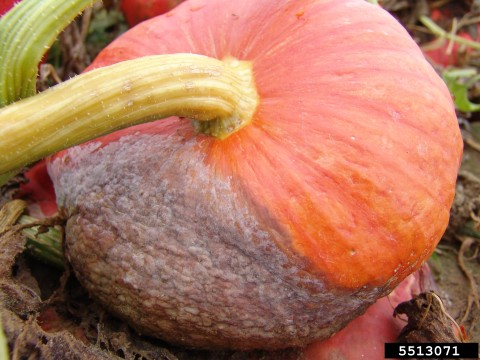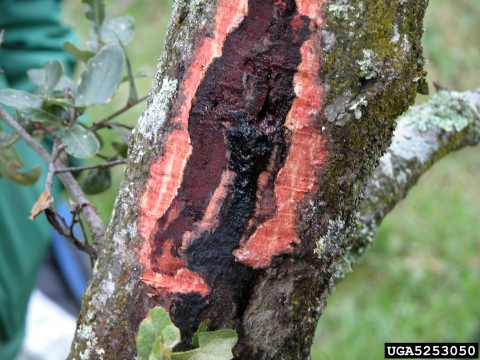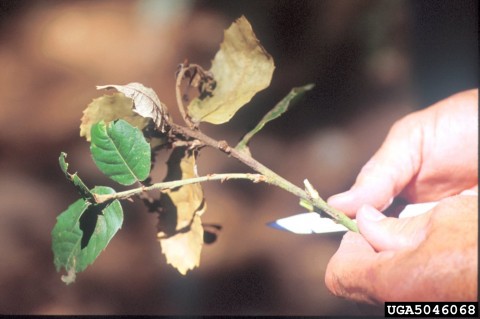
Phytophthora root rot in pumpkin. G. J. Holmes, Bugwood.org.

Phytophthora root rot in tree. Joseph O’Brien, USDA Forest Service, Bugwood.org.
Phytophthora is a soilborne pathogen that causes crown and root diseases in a number of western Washington plants. There are several species of Phytophthora. These organisms may infect fruit and nut trees, ornamental trees and shrubs, tomatoes, peppers, eggplant, squash and other vegetable crops.
Unfortunately, root rot fungi are usually well established before symptoms of infection appear. Depending on cultural conditions, age of plant and species of pathogen, an infected plant may slowly decline or die suddenly.
Plants can develop Phytophthora rot if the soil around the base of the plant remains warm and wet for long periods, or if the plant is planted too deeply. Flooded or saturated soils, or soil along river banks and ponds, are ideal environments for phytophthora organisms to thrive, reproduce and infect plants.
Symptoms
- Leaves may appear drought stressed.
- Leaves may turn dull green, yellow or sometimes red or purple.
- Stems may severely die back.
- Trees or plants may lose vigor, wilt and die.
- Trees may develop dark areas in the bark around the crown or upper roots.
- Vegetables may develop water-soaked spots in the roots. These may dry out and turn brown as the disease progresses. Early infections (damping-off diseases) may kill seedlings.
How to manage
Get a laboratory soil or tissue test for positive identification of root rot organisms and diseases. Different diseases have similar symptoms.
If the soil test shows Phytophthora, talk to us about deep root injections that can help support plant health.
Most important is managing water and drainage. Don’t allow the soil to remain saturated. Likewise, avoid standing water around the base of trees or plants. Irrigate only as much and as often as necessary.
Correct soil drainage problems. This may require breaking up compacted soil to improve drainage. You could also consider planting trees and shrubs in mounds and vegetables in raised beds.
When planting, make sure the upper roots are near the soil level and the graft union is well above the soil line.
Choose certified nursery stock from a reputable source. Choose the most resistant rootstocks or varieties available. Contact us if you would like recommendations for resistant plants or substitute species.
If your tomatoes have been infected by Phytophthora root rot, don’t plant tomatoes, eggplant or peppers in the same soil for at least one or two seasons. Make sure the soil is allowed to dry out as deeply as possible.
Sudden oak death

Sudden oak death. Joseph O’Brien, USDA Forest Service, Bugwood.org.
Sudden oak death, caused by Phytophthora ramorum, is a serious plant disease that attacks many types of plants and trees common to the Pacific Northwest, including azaleas, big leaf maples, huckleberry, California bay laurel, camellia, myrtles, honeysuckle, Pacific madrone, Douglas fir, rhododendrons, and viburnum.
It has killed hundreds of thousands of trees in California. It has also infected plants at nurseries in California, Oregon, and Washington. Oregon and Washington states have imposed quarantines to slow the spread of the disease.
Symptoms vary from plant to plant, and may include leaf spots, needle and tip blight, shoot-tip dieback, and canker formations. Many other plant pathogens cause the same symptoms. The only way to confirm the presence of sudden oak death is through laboratory testing.
References
Phytophthora Root and Crown Rot in the Garden. University of California . Statewide Integrated Pest Management Program. http://www.ipm.ucdavis.edu/PMG/PESTNOTES/pn74133.html.
Diagnosis and Control of Phytophthora Diseases. Pscheidt, J.W. Pacific Northwest Plant Disease Management Handbook. http://pnwhandbooks.org/plantdisease/pathogen-articles/pathogens-common-many-plants/oomycetes/diagnosis-and-control-phytophthora-diseas-1.
Sudden Oak Death. Washington State Department of Agriculture. http://agr.wa.gov/plantsinsects/diseases/sod/.
Landscape Plant Problems: A Pictorial Diagnostic Manual. Byther. R.S., Foss, C.R, Antonelli, A. L. Maleike, R.R., and Bobbitt, V.M. Washington State University Cooperative Extension, 2000.
Pacific Northwest Landscape IPM Manual. Bobbitt, V.M., Antonelli, A.L., Foss, C.R., Davidson R.M., Byther, R.S, and Maleike, R.R. Washington State University Cooperative Extension, 1996.
Pests of Landscape Trees and Shrubs: An Integrated Pest Management Guide. Dreistadt, S. ANR Publications, University of California, 1994.
